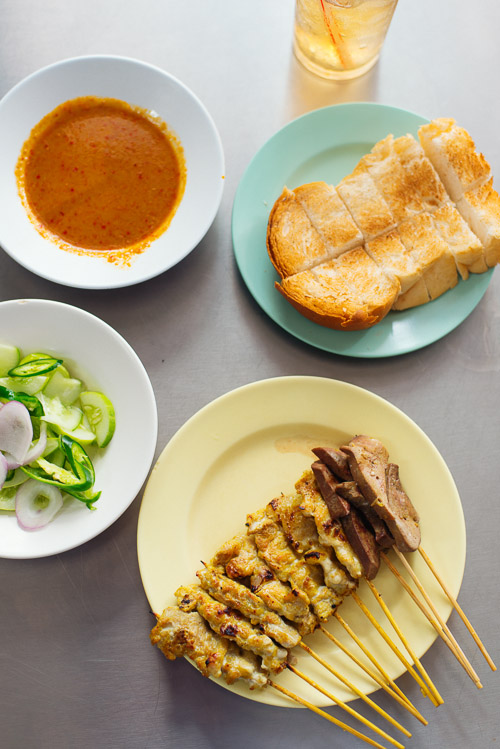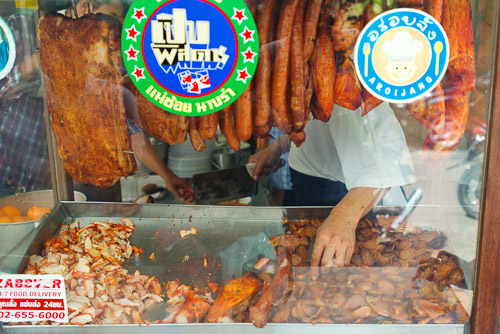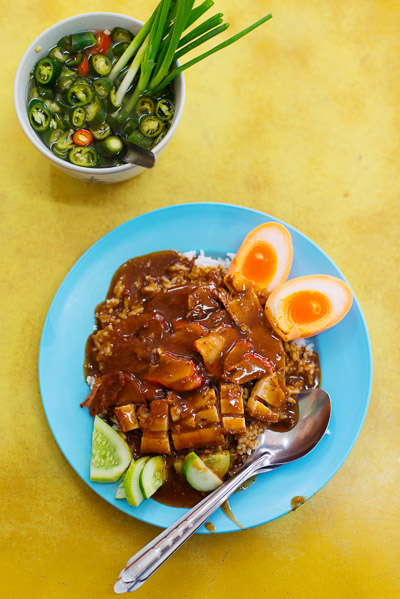 There's a widespread perception that Thai food is spicy. And justifiably so. Thai people -- women in particular -- seem to relish in eating devastatingly hot dishes, and even have a repertoire of only marginally translatable words to express the equal parts painful and pleasurable sensation of doing so (example: เผ็ดจนหูอื้อ, phet jon huu eu, roughly "so spicy your ears ring").
There's a widespread perception that Thai food is spicy. And justifiably so. Thai people -- women in particular -- seem to relish in eating devastatingly hot dishes, and even have a repertoire of only marginally translatable words to express the equal parts painful and pleasurable sensation of doing so (example: เผ็ดจนหูอื้อ, phet jon huu eu, roughly "so spicy your ears ring").
But it's certainly not the case that everything in Thailand is spicy. In fact, many of the dishes sold on the streets or from the shophouses of Bangkok -- particularly those of Chinese origin -- tend to be quite mild, sometimes bordering on bland.
One of the more famous examples of this is satay. Although the dish is most likely Indonesian in origin and appears to have been brought to Thailand by Chinese immigrants, in the US, the peanut-based dipping sauce that accompanies the skewers of meat has somehow become synonymous with Thai food. Origins aside, in Thailand at least, I'd never cared for the stuff. Most versions are dry and relatively flavourless, and come served with an cloyingly sweet dipping sauce -- a far cry from the delicate, fatty, spicy skewers and rich sauce one encounters in the dish's country of origin or even in Malaysia.
But a recent discovery single-handedly changed my opinion about Thai-style satay. Chong Kee, a longstanding shophouse restaurant at the edge of Bangkok's Chinatown, specialises in the dish -- in fact, it's the only dish they serve. Like elsewhere, the skewers have been marinated in a mixture of coconut milk, turmeric and dried spice. Unlike elsewhere, the skewers at Chong Kee are smoky and surprisingly tender. They use fattier cuts of pork (the staple meat for this dish in Thailand), which don't dry as quickly, and are great at soaking up all that flavourful smoke (they also serve a somewhat unusual liver version). The accompanying peanut sauce is sweet, as it should be, but not overwhelmingly so, and also packs a tiny bit of chili spice and a pleasantly fragrant hint of coriander seed. Other sides include ajaat, sliced shallots, chili and cucumber in sweet/tart dressing, and thick slices of fluffy white toast.
Next door, another longstanding restaurant sells an equally mild but delicious dish: khao muu daeng, rice topped with roast pork.
An 'everything' order here will get you a plate of rice topped with thin slices of bright red roast pork, crispy fingers of deep-fried pork belly and rich, fatty disks of Chinese-style pork sausage. The whole lot is topped with a slightly rich, somewhat sweet, very gloopy sauce:
Soft-boiled eggs (made orange by the addition of food colouring) and a condiment of mild chilis in vinegar are optional sides.
The pork belly is great -- rich, crispy, fatty -- and the kun chiang (Chinese sausage) also good, but the roast pork is pretty mediocre -- more red food colouring than flavour. Regardless, the whole thing comes together in a favourably mild way that will trick you into wanting a second dish.
In addition to pork and rice, they also do a few excellent Chinese-style soups. Duck in broth made tart with pickled lime is available every day, while pork rib and bitter gourd:
and pork stomach with Chinese-style pickled vegetables are available intermittently.
Two solid options for spice-fearing and adventurous eaters alike.
Si Morakot/สีมรกต 80-82 Soi Sukon 1, Bangkok 11am-7pm
Chong Kee/ชองกี่ 84 Soi Sukon 1, Bangkok 9.30am-6pm Tues-Sun, to 2pm Mon
View Thai Eats in a larger map














